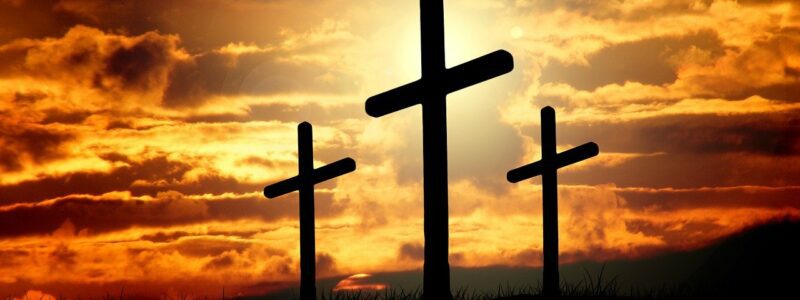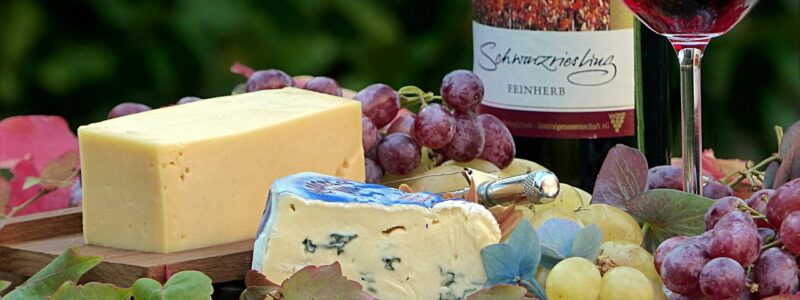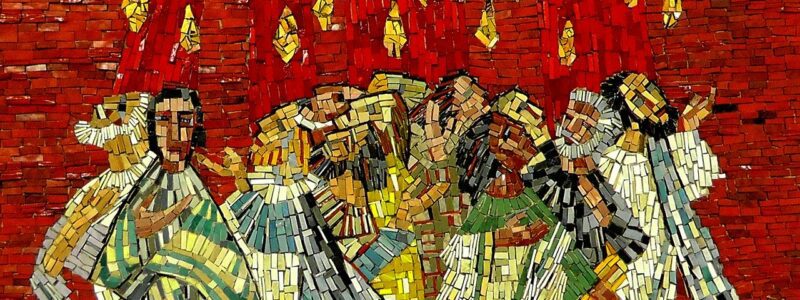The Jewish Passover

Lamb – Image by cocoparisienne from Pixabay
The Jewish Passover is one of the holiest days of the year. It celebrates the time when Moses confronted the Pharaoh in Egypt to “let the people go.”
The problem was that Egypt did not want to let its slave population go – they depended upon the Jewish population’s slave labor. This brought about a classic confrontation between Moses and the Pharaoh resulting in multiple plagues or calamities against Egypt.
The plagues were not just random occurrences either; each one was directed against a specific Egyptian god to show the one Hebrew God to be superior to the multiple Egyptian ones.
The Pharaoh responded to these plagues by initially letting the slaves leave but always changed is mind. Finally, the last plague resulted in the death of the firstborn male from every family in Egypt – except the Hebrews. The angel of death literally “passed over” the houses of the slaves whose doors were pained with the blood of a male lamb foreshadowing the death of Christ.
The Jews were later commanded to have a perpetual remembrance of the Passover with a Passover meal so they would remember the goodness of God, but also to help them recognize the Messiah when he would appear about 1500 years later.
Jeff Considers His Nightly Lessons
Jeff was angry with himself. He woke up the next morning along in his house; he had spent a fortune buying expensive paintings – even a Matisse which was hanging over his fireplace – but had no one to share it with. What was the use of having all the baubles of life if not to impress, and how can you impress with no one there! Jeff thought about doing some stock market research – something to sell his vapid customers but somehow he simply had no energy for that. In fact, he had no energy for anything.

Porsche – One of Jeff’s “toys” – Image by Michael Gaida from Pixabay
He certainly did not want to watch television, rent a movie, or even go outside his house. The new Porsche he had just bought with cash a few months ago would just have to sit idle in his garage until Monday – or never. Jeff started to do what anyone would do when trying to escape from his thoughts that life was passing him by; what was the use of life anyway? Is this all there is to life? He recently heard a cute analogy from one of his drinking buddies;
Life is like a game of monopoly. You go around the board a few times, pick up a few houses, have some fun – but at the end of the day everything went back into the box.”
Jeff was depressed and alone with his thoughts. He certainly didn’t particularly want to die – there was no fun at that. But if the accumulation of wealth was all there is, well – what was the purpose of living? He thought of another one-liner he had seen on any number of car fenders; “The winner in life dies with the most toys.” Really, is that it?
Jeff then looked around him at all his accumulated possessions; the Matisse over the fireplace, the Porsche in the garage, solid gold silverware and ornate china – all this stuff; why? What was the purpose?
Jeff certainly didn’t gain any pleasure by giving any of his material possession away. Oh sure, he got mail for local charities asking for money; like the local charity asking for a car donation. “Imagine that,” Jeff recalled thinking, “asking for a car! I certainly don’t want to give any of my cars to some charity! Why can’t these freeloaders do honest work – oh, I don’t know, like washing cars for money rather than begging honest people for donations!”
 Then there were the beggars at the store entrances, asking for “a little change!” Or, the Salvation Army – how pitiful is that! Jeff remembers his annoyance at hanging to go around some guy ringing a bell over a kettle (of all things), asking for money and being – well, a general nuisance.
Then there were the beggars at the store entrances, asking for “a little change!” Or, the Salvation Army – how pitiful is that! Jeff remembers his annoyance at hanging to go around some guy ringing a bell over a kettle (of all things), asking for money and being – well, a general nuisance.
So, Jeff settled down in his house to do what any honest, bored man disgusted with his life wondering why he bothered to collect all this stuff; he started drinking. First, a few beers, and then he brought out the vodka. After downing about half a bottle, Jeff collapsed in his expensive leather sofa and passed out – cold, stone drunk.
While he would pay for his “indiscretion” later with a splitting headache while retching at the commode, he would pay now with another visitation from his angelic friend. Apparently, ethanol induced stupor is just as conducive to celestial visitations as natural sleep. He did find, however, that the intensely bright light which shone forth from the angel to be particularly bothersome to his alcohol ravaged nervous system. He had no choice but to listen to whatever the angel had to say.
The Angel Returns to discuss The Jewish Passover
“Son of Earth, I see you have not been kind to your earthly body. You will find it impossible to escape from my messages until the time of your death; that is part of God’s gift to your mother after her years of faithful prayer. Whether to accept the message if your choice; however, whether to hear my message is my choice.”
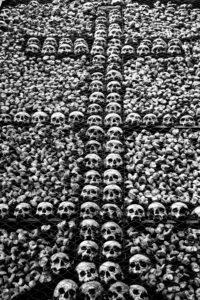
Photo by Gábor Molnár on Unsplash
“Angel, I find your messages fascinating but at the same time, annoying. I can see in my mind a panorama of ancient history as you speak – almost like watching a movie. I could actually see Moses – at least that’s who I guess it was – speaking to the Pharaoh; and I felt the agony of countless mothers who lost their firstborn child through no fault of their own. How could a so-called loving God bring so much misery to so many people! How could God put his to people – his chosen to people – into bondage and slavery for hundreds of years? Why does God let so much misery happen to so many people?”
“Son of Earth, we will talk about evil later; but understand this, there is great evil in the world for sure. God could have allowed mankind to tear itself apart as it certainly would have done without his presence. But instead, he chose to sacrifice himself by allowing the Romans to whip the skin and muscle off his bones and then be nailed naked to a slab of wood to die a miserable, painful slow death so reconcile mankind to himself.”
“Well, there must have been an easier, better way; why allow such misery in the world in the first place?”
“There are many answers to that question, Son of Earth, but you will have to resolve your doubts by yourself. Only know this; there is no pain or suffering that is not worth the glorious eternal future God has prepared for you if you will but accept it.”
“I don’t know, angel. Why is there so much pain and suffering with a so-called loving God?”
“Son of Earth, what have you done with your life to relieve some of this ‘pain and suffering?’ You have tossed away several letters asking for help to provide food for the poor in this community, and there was a letter last week for contributions to provide housing for poor children, medicines for malaria for sick people in Africa, and research to help find a cure for cancer. You spend all your money on yourself and yet you are not happy. Then you shake your self-righteous fist at God but have not done a thing to help your fellow man.”
Jeff was beaten. He knew he was no match for an angel – especially in his drunken state. Perhaps it was the alcohol that was presenting him from presenting a cogent argument. No matter – the angel would proceed with his information and he would put off thinking about this until later when he could think clearly.
The Passover

Passover Lamb – Image by David Mark from Pixabay
“Son of Earth, I will continue with what I have to say tonight. As you remember, we were talking about Passover when our time ran out. At the time of the Passover, the Jewish family would take the little one-year-old lamb that had been with them for four days to the Temple to be sacrificed and then brought back home to be eaten that night.”
“Yes, angel, I remember we had talked about that; it all seems so unnecessarily cruel to kill all those poor innocent animals.”
“Crucifixion” of the Passover Lamb During the Jewish Passover
“There was even more symbolism in the way the Jews would prepare the lamb. You see, the knowledge of these customs have been lost to most Christians because they have lost their Jewish heritage. This ignorance is a great victory of the Evil One as Christians fail to understand how these Jewish rituals fit in with their Christian faith.”
“There is historical evidence that the lamb was roasted upright hanging on a pomegranate pole with a crossbar through its shoulders and another stick through the Passover lamb from its mouth to its buttocks’”. As one expert concluded,
An examination of the rabbinic evidence … seems to show that in Jerusalem the Jewish paschal lamb was offered in a manner which resembled a crucifixion.
“This is further substantiated by the writings of Justin Martyr who wrote,
For the lamb, which is roasted, is roasted and dressed up in the form of a cross. For one spit is transfixed right through from the lower parts up to the head, and one across the back, or which are attached the legs of the lamb. (Justin Martyr, Dialogue with Trypho the Jew)
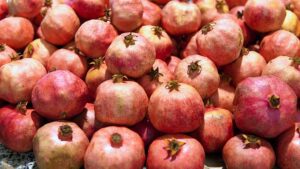
Image by Matthias Böckel from Pixabay
Jeff pondered this for a few moments before confirming what he had just heard. “So the upright lamb with a pomegranate pole and crossbar seemed very symbolic of the cross upon which the Lamb of God would be sacrificed many years later!”
“Right, Son of Earth. Pomegranate is symbolic of royalty and the priesthood so it is natural that the symbol of future royalty and priesthood would be associated with that particular wood. And there was another custom which pointed to the future Messiah; the bowels of the lamb would be placed about the head so that everything would be cooked evenly without boiling; this resembles the crown of thorns which was on Christ’s head while he was sacrificed.”[1],[2]
“So right there in front of the Jewish family was a visual picture of sorts of Christ’s death.”
“But the picture is even more graphic. Think of this; when each Jewish family was choosing their perfect lamb on the tenth day of Nisan for their Passover meal four days later, God was choosing his Lamb at the triumphant entry of Christ into Jerusalem on what we now call Palm Sunday. During the next four days, the lamb would be inspected to be sure it was perfect just as Christ was tested by the Pharisees during his last week in Jerusalem and during his mock trial. On the day and hour that the lamb was being sacrificed in the Temple to be taken home by each family to prepare and eat, Jesus, the lamb of God was being crucified on the cross. This is why the lamb being roasted upright on a pole becomes such an important visual image.”
“So Christ was sacrificed for us at the same time that the Passover lambs were being sacrificed for the sins of Israel on that fateful day!”
“Right, Son of Earth! But there is more.”
“More?”
“Yes. I will ask you a question after I read this important bit of Scripture that is very familiar,”
And in the same region, there were some shepherds staying out in the fields, and keeping watch over their flock by night. And an angel of the Lord suddenly stood before them, and the glory of the Lord shone around them, and they were terribly frightened. And the angel said to them, ‘Do not be afraid; for behold, I bring you good news of a great joy which shall be for all the people; for today in the city of David, there has been born for you a Savior, who is Christ the Lord. And this will be a sign for you; you will find a baby wrapped in cloths, and lying in a manger.[3]
“Of course; that is the Christmas story! It is probably one of the best-known pieces of Scripture where the Christ child is announced. Many millions of Americans who never read the Scriptures were introduced to this on the Charlie Brown Christmas Special.[4]”
“Son of Earth, since you know this Scripture so well, why is this a sign – to find a baby wrapped in cloths lying in a manger?”
“Well – uh, I guess I don’t. We all kind of rush right past that part of the story without a second thought. Why would that be a special “sign” to the shepherds?”
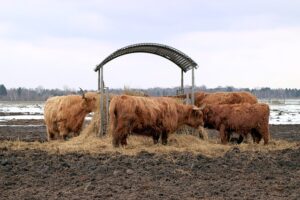
Cattle eating from a manger – Image by David Mark from Pixabay
“Son of Earth, many remember the ancient prophecy that predicted the Messiah would be born in Bethlehem,[5] but few are familiar with another prophecy that the Messiah would be announced at the tower of the flock (Migdal Eder).[6] It turns out that this tower was a two-story structure that had been in the pasture outside Bethlehem on the road to Jerusalem; the remains of the tower have just recently been discovered[7]
Furthermore, the shepherds in the field on this night were not just some group of lowly sheepherders but were Temple priests to assist in the birthing of the sacrificial lambs so that they would be born without blemish and could be used for the Passover sacrifices the next year.
While the shepherds were keeping watch over the flock at night, the priests would bring pregnant lambs onto the bottom floor to take care of the newborn lambs. As soon as the lamb was born, it would be placed in cloths made from old priestly undergarments in order to keep the lambs from being blemished. Then, they would place the lamb into a manger (feeding trough) to be sure it wouldn’t be trampled. So that first Christmas day when the shepherd-priests went into Bethlehem and saw the baby wrapped in cloths lying in a manger they might have exclaimed, “This is the Lamb of God, wrapped in cloths, unblemished!”
“I never knew any of those details, angel! So that is why the visual appearance of the Christ child lying in a manger wrapped in cloths would be a “sign” to the shepherds; they would immediately recognize him presented just like the sacrificial lambs they were putting in mangers nearby in the tower!”
“I have more, a lot more, to tell you tonight. Remember how each Jewish family would take a lamb to the Temple to be slaughtered so they could take it home, roast the lamb in a certain way, and then eat it during the Passover meal. How do you think they knew they got their lamb back again after it was slaughtered?”
“I don’t have the slightest idea!”
“Each family would place the family name around the neck of their lamb. Look at some of the greatest masterpiece paintings of Christ on the cross; there was a small sign in many of these paintings with four letters, INRI[9] This sign represents the one that Pontius Pilate placed on the cross,”
And Pilate wrote an inscription also and put it on the cross. And it was written. Jesus the Nazarene, the King of the Jews.[10]
“These four letters stand for the Latin translation of the sign:”
Iesus Nazarenus Rex Iudaeorum
“But, Pilate didn’t just have the sign in Latin on the cross; it was also in Hebrew and Greek so that everybody would know who this man was. This is the Hebrew version which we don’t see very often because until very recently no one spoke Hebrew,”
יהושע הנצר ומלך היהודים
Y’Shua HaNatzri V’Melech HaYehudim
Jesus the Nazarene King of the Jews
“Well, so what, angel?”
“Now, when you look at the first letters of these words, it spells “YHVH” – the name of God, being the Anglicized form of Jehovah! So, just like the Jews put their family name on their lambs which were sacrificed at the Temple for them, God put his name on his lamb for his family – which includes all humanity.”
“Wow, that is pretty amazing! So that Y’Shua – which is Christ’s Hebrew name, is included in God’s name!”
“That’s right, Son of Earth!”
“Angel, these things are amazing, what you are telling me. They indicate a strong connection between the original Passover celebration which started in Egypt and Christ’s crucifixion. Just like the Passover lamb was a sacrifice meant to cover the sins of that family, so did the sacrifice of the Lamb of God cover the sins of mankind. Why is it we never hear the details of this connection in our churches today. I mean, I had gone to church for years and never heard of this stuff.”
“Son of Earth, it is because most pastors or ministers have never heard of these things either!. As you said, the Jewish part of Christianity has been lost for centuries! It is almost as if it had been censored out. Early Christians blamed the Jews for the death of their Messiah, and so all Jewish remnants were expunged from Christianity. This prejudice today is expressed in utter hatred of Israel by many countries across the world. Many go to church in the morning and worship a Jewish Messiah while hating all things Jewish the rest of the week.”
“That is such a shame; people have hated the Jews for centuries.”
“Son of Earth, you know about Communion – or Eucharist, right?”
“Well sure!”
“And you know there are many differences of opinion exactly what the Eucharist represents among different Christian denominations?”
“Of course. Most Christians, even those who deny that there is any real change in the bread or wine used, recognize a special presence of Christ in this rite. But Christians differ about exactly how, where and how long Christ is present in it.[11]
“That’s exactly right, Son of Earth. Some churches only use grapefruit juice or even water rather than wine. But the real difference is exactly what is represented by the bread and wine (or grapefruit juice or water).
“Right. I think I remember some of this. The exact meaning of the Eucharist has been a very divisive force throughout the history of the Christian church. Catholics, for example, will even worship the Eucharist itself believing it is the actual body and blood of Christ – even though it “looks like” mere bread and wine.”
“That is right, Son of Earth.
- Catholicism, Eastern Orthodoxy, Oriental Orthodoxy, and the Church of the East teach that the reality (the “substance”) of the elements of bread and wine is wholly changed into the body and blood of Jesus Christ, while the appearances (the “species”) remain. Transubstantiation[12] is the term used by Catholics to denote what is changed, not to explain how the transformation occurs, since the Catholic Church teaches that “the signs of bread and wine become, in a way surpassing understanding, the Body and Blood of Christ”.[13]
- Lutherans believe that the body and blood of Jesus are present “in, with and under” the forms of bread and wine, a concept known as the sacramental union.[14]
- The Reformed churches, following the teachings of John Calvin, believe in an immaterial, spiritual (or “pneumatic”) presence of Christ by the power of the Holy Spirit and received by faith.
- Anglicans adhere to a range of views although the teaching on the matter in the Articles of Religion holds that the presence is real only in a heavenly and spiritual sense. Some Christians reject the concept of the real presence, believing that the Eucharist is only a ceremonial remembrance or memorial of the death of Christ.”[15]
“Angel, there seems to be a real confusion among Christian churches as to what all of this means.”

Grapes for Communion Wine – Image by Jill Wellington from Pixabay
“Yes, Son of Earth, there is confusion about the Communion as there is about other Christian issues – Satan has been very successful in dividing the church and making it ineffective and largely impotent in the world today. But I am here tonight to discuss how the Passover meal – the Seder – is connected to the Christian Eucharist. The “real” meaning of the Eucharist might be glimpsed with how Christ approached the Seder at his last meal.”
“Why, what do you mean?”
“Son of Earth, the Haggadah[16] is a Jewish text which gives the exact order of the Seder meal and provides a ceremony that satisfies the scriptural commandment for each generation to teach the next about the Jewish liberation from slavery in Egypt as described in the Torah.[17] The most interesting part of the Seder meal for our discussion concerns the four different cups of wine served during the meal and what they mean in the Jewish tradition and their importance to Christians.”
“OK, but what could be so important about the Seder to modern Christians?”
“Each of the four cups at the Seder inner on Passover has its own significance.
- The first cup is taken at the beginning of the ceremony and is called the “Cup of Blessings or Sanctification.” It refers to the phrase “I will bring you out …” wherein God promises to bring the Jews out from Egypt. This cup also is symbolic for taken out of the world, separated from the rest of the world and becoming a “chosen people,” and being separated from sin.
- The second cup is the “Cup of Praise” which is taken in remembrance of God’s promise, “I will deliver you from bondage.” After the meal, everybody drinks from
- the third cup or the “Cup of Redemption.” At the Last Supper in the upper room on the day before he was killed, Christ said, “For this is My blood of the covenant, which is poured out for many for the forgiveness of sins.”[18] So, the third cup at the Passover is the one every Christian takes at Communion.
- The fourth cup is called the “Cup of the Kingdom” which Christ did not take at the end of their Seder meal. Instead, he said “But I say to you, I will not drink of this fruit of the vine from now on until the day when I drink it new with you in My Father’s kingdom.”[19]
Christ did not drink the fourth cup because the “kingdom” has not yet been established – and it is still in the future, son of Earth.”
“And it is that “kingdom” we speak about in the Lord’s Prayer, ‘Thy kingdom come” – right?”
“That’s right Son of Earth. And there is another reason why we don’t drink the fourth cup yet. It has to do with the symbolism of a Jewish wedding.”
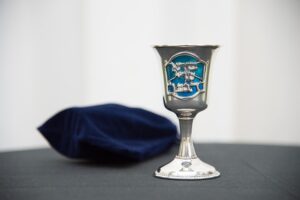
Image by danafleitman from Pixabay
“What’s so special about a Jewish wedding, angel?”
“In ancient Israel, there was a custom about how a Jewish courtship and eventual wedding would unfold, but the really important part of the wedding is that it symbolizes the eventual wedding still in the future between Christ and his church.”
“So you mean to tell me that somehow a Jewish wedding in ancient Israel was fashioned in such a way so as to symbolize Christ’s dealing with the church? If I’m not mistaken, the church had not even been created when Christ was alive, is that not correct?”
“Correct Son of Earth. The establishment of the church did not happen until the Pentecost which happened after Christ departed, so the participants in the ceremony were totally unaware of the deeper significance of their courtship.”
“That’s kind of interesting – tell me more!”

Bride – Image by Sasin Tipchai from Pixabay
“Then a Jewish man would propose marriage to a prospective bride, he would offer a cup of wine. If she drank the wine – the Cup of Betrothal, she was accepting the proposal and was then engaged to be married. The man would then inform his fiancee that he would be going to his father’s house to prepare a place for her. When the place was completed, the groom’s father would then tell him that it was time to go and retrieve the bride. In this way, the man did not know the time or date when he would be getting married to his bride – it was actually up to the father. The wedding celebration then lasted seven days after which the newly minted husband and wife would start a feast by drinking together a cup of wine called the “Cup of Consummation.” This cup – the Cup of Consummation – is the same as the fourth cup of the Seder “Cup of the Kingdom.” So, after the disciples and Christ drank the third cup which was symbolically the “Cup of Betrothal,” Christ told them that he was going to his father’s house to prepare a place for them – just like a Jewish young man would go to prepare a place for his fiancee.[20]
“So angel, see if I have this right. You are telling me that the Seder meal and the Jewish betrothal and marriage ceremony share a commonality in the symbolism of cups of wine?”
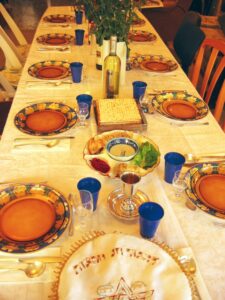
Sedar Table – By Gilabrand at en.wikipedia, CC BY 2.5, Link
“That is correct, Son of Earth. So the important thing to remember is when Christians take the cup in the Communion ceremony, we are actually acting as the Bride (church) accepting a betrothal request from Christ. In the future kingdom, we will drink the “Cup of Consummation” with Christ at the “Marriage Feast of the Lamb;” that will be the Kingdom Cup of the Last Supper – the one that Christ did not drink at the Last Supper.”
“Well, that’s interesting – but what about the bread we eat at Communion?”
“The bread that is eaten at a Seder meal is matzah – or unleavened bread – that is, with no yeast. Yeast in Scripture is symbolic of sin. When you purchase matzah bread at a store, it looks like a large Saltine cracker. The bread is baked in such a way that it is pieced with tiny holes in rows giving a striped appearance, with brown spots on it like bruises. Since the temple is no longer in existence for the sacrifice of one-year old lambs, the rabbis ruled that the matzah bread could suffice for the lamb. Interestingly, this substitution ties in with Scripture,”
But he was wounded for our transgressions, he was bruised for our iniquities: the chastisement of our peace was upon him; and with his stripes we are healed.[21]
“So angel, the matzah substitutes for the lambs used by the ancient Jews; that’s probably a good thing. It would be difficult for most modern Jews to keep a lamb in their house for even a few days! But the visual picture of stripes and bruises on the matzah bread means the Jews were unknowingly symbolizing the death of Christ in a similar way that the lambs did.”
“But there is more symbolism. Can you see now, Son of Earth, why the Passover meal should be important to Christians? But sadly, it is all but forgotten.”
“I see your point, angel.”
“At the Seder at the head of the table is kept a pouch called the matzah tosh which has three compartments, each of which has a piece of matzah bread in it. The Jews understood that the three pouched illustrated the three Patriarchs – Abraham, Isaac, and Jacob. Christians might understand the symbolism in a different way, referring to the three pockets as representing Father, Son and Holy Spirit.”
“OK – so what?”
“These two understandings are not mutually exclusive; for example, God called Abraham out of the Chaldees and in a similar fashion, God the Father has called us before the foundation of the world to be separated from the world.[22]
Similarly, Isaac was nearly sacrificed on Mount Moriah – the sample place where the Temple was later built – picturing substitutionary atonement, the one that Christ would later offer at Calvary. The third pouch represents the work of the Holy Spirit in sanctification producing a holy man in Jacob who was initially a prideful liar.”
“OK, so what you are saying is that the three pouches of this thing at the head of the table represent Abraham (being called out), Isaac (sacrifice), and Jacob (sanctification). Is that right?”
“Exactly right, Son of Earth.”
“But why is that important to Christians today. I can see why the Cup of Betrothal at the Jewish wedding ceremony would be very significant for Christians because it pictures the betrothal of the church to Christ.”
“Here is what you need to know; it is a tradition that the matzah in the middle compartment is removed and broken in half. The half piece is called the afikomen and is wrapped up in a cloth and hidden for later retrieval by the children at the end of the meal. When a child finds the afikomen, he is given a gift usually in the form of money.”
“OK, so …”
“The afikomen in the second pouch – the Christ pouch if you will – is a picture of Christ’s sacrificial death. Christ was broken (killed), wrapped in cloth, and hidden (buried) later to come forth again.[23] The word “afikomen” is a Greek word meaning “that which is coming.” It might refer to the desert which is coming next in the meal, but many take it to mean “he who is coming.” According to Jewish tradition, Messiah will come at Passover to bring redemption – that is why a place is left at the Passover table for Elijah who would be the forerunner of Messiah.”
“So there is a lot of Christian symbolism in the Passover Seder. I guess the sad thing is that the Jews don’t see this symbolism because they don’t recognize Christ, while the Christians don’t recognize the symbolism because they don’t know about the deeper meanings of the Passover! There it is again; truth hidden in plain sight.”
“That is all true, Son of Earth. Please ponder these things carefully because we will build upon them in future visitations.”
And with those words, light in the room began to dissipate and the angelic form dissolved away.
Jeff was back in his room again; the only difference was he was paying the price for his drunken stupor. He wondered whether the last visitation might just be another hallucination; a product of his delirious, alcohol affected brain. He considered that thought for a while, but was too fatigued to give it much consideration. He would have to research what the angel purportedly had told him in his dream; he figured that way he could discern whether all of that information was true – or just a fevered product of disordered neurons. He would have to remember to do that – someday.
[1] Tabory, James, The Crucifixion of the Paschal Lamb. Jewish Quarterly Review; New Series, Vol. 86, 1996, pp. 395-406
[2] Edersheim, Alfred, The Temple: Its Ministry and Services, chapter 12, “The Paschal Feast and the Lord’s Supper”, 1995
[3] Luke 2:8-12
[4] https://www.youtube.com/watch?v=DKk9rv2hUfA
[5] Micah 5:2
[6] Micah 4:8
[7] http://hethathasanear.com/Birth.html
[8] http://en.wikipedia.org/wiki/Passover_sacrifice
[10] John 19:19
[11] “Most Christian traditions also teach that Jesus is present in the Eucharist in some special way, though they disagree about the mode, the locus, and the time of that presence” (Encyclopædia Britannica Online)
[12] http://en.wikipedia.org/wiki/Transubstantiation
[13] Catechism of the Catholic Church (The Vatican)
[14] http://en.wikipedia.org/wiki/Sacramental_union
[15] http://en.wikipedia.org/wiki/Eucharist
[16] http://en.wikipedia.org/wiki/Haggadah
[17] Exodus 13:8
[18] Matthew 26:28
[19] Matthew 26:29
[20] Norten, Michael, p. 22
[21] Isaiah 53:5
[22] Ephesians 1:4-5
[23] http://www.chosenpeople.com/main/holidays-and-festivals/594-the-origin-of-the-afikomen

